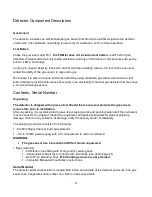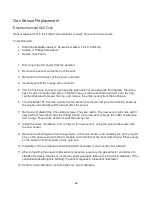
19
Gas Sensors
General Information & Environmental Effects
with water. The sensor can gradually be restored to balance without permanent damage by exposure to
lower relative humidity.
Likewise, continuous operation at 0-15%RH will cause the sensor to dry out, which can cause the acid
electrolyte to attack the seals. This occurs if the volume of electrolyte decreases by more than 40%. If
not left in this condition too long the sensor can be restored by exposing the sensor to RH humidity
above 15%.
Temperature
Both the baseline (zero point) and output span are affected by temperature. The baseline
approximately doubles with every 10°C increase in temperature. The output span will increase slightly
up to about 10% before leveling off with gradual increase in temperature. A transient spike can occur
with rapid changes in temperature; this should go away after 30 seconds.
Maximum Overload
The gas sensor maximum overload rating, for chlorine it is 250 ppm, is specified in terms of maintaining
a linear response over a 10-minute exposure and recovering quickly. At higher levels the sensor will
progressively become more non-linear and take increasingly longer to recover as the sensing electrode
is unable to consume all the gas diffusing to it.
If the gas level is increased even further gas will build up inside the sensor and diffuse into the internal
spaces where it may interact with the reference electrode, altering its potential. If this happens the
sensor may take several days to recover once placed in clean air.
Sensor Zero Point Drift
Over time all gas sensors will experience a shift of the zero, or reference point. When this happens the
gas concentration readings will also shift accordingly, producing inaccurate readings.
Note that sensor responsiveness will vary with environmental conditions.
Typically gas exposure mentioned throughout this document refers to the target gas, however exposure
to interfering gases can cause similar effects as target gas exposure.
Causes of gas sensor zero point drift include:
•
Chemical degradation of the sensor over time.
•
Temperature, affecting both the span and zero point
•
Repeated use in extreme high or low temperature or humidity conditions, or environments with
high levels of airborne particles. Temperatures above the rated limit stress the seals, which will
cause electrolyte leakage.
Содержание FX-Mini
Страница 2: ...2 Page intentionally left blank...
Страница 30: ...30 Gas Sensor Components See page 26 for Ammonia Ozone and Hydrogen Cyanide sensor components...
Страница 35: ...35...
















































